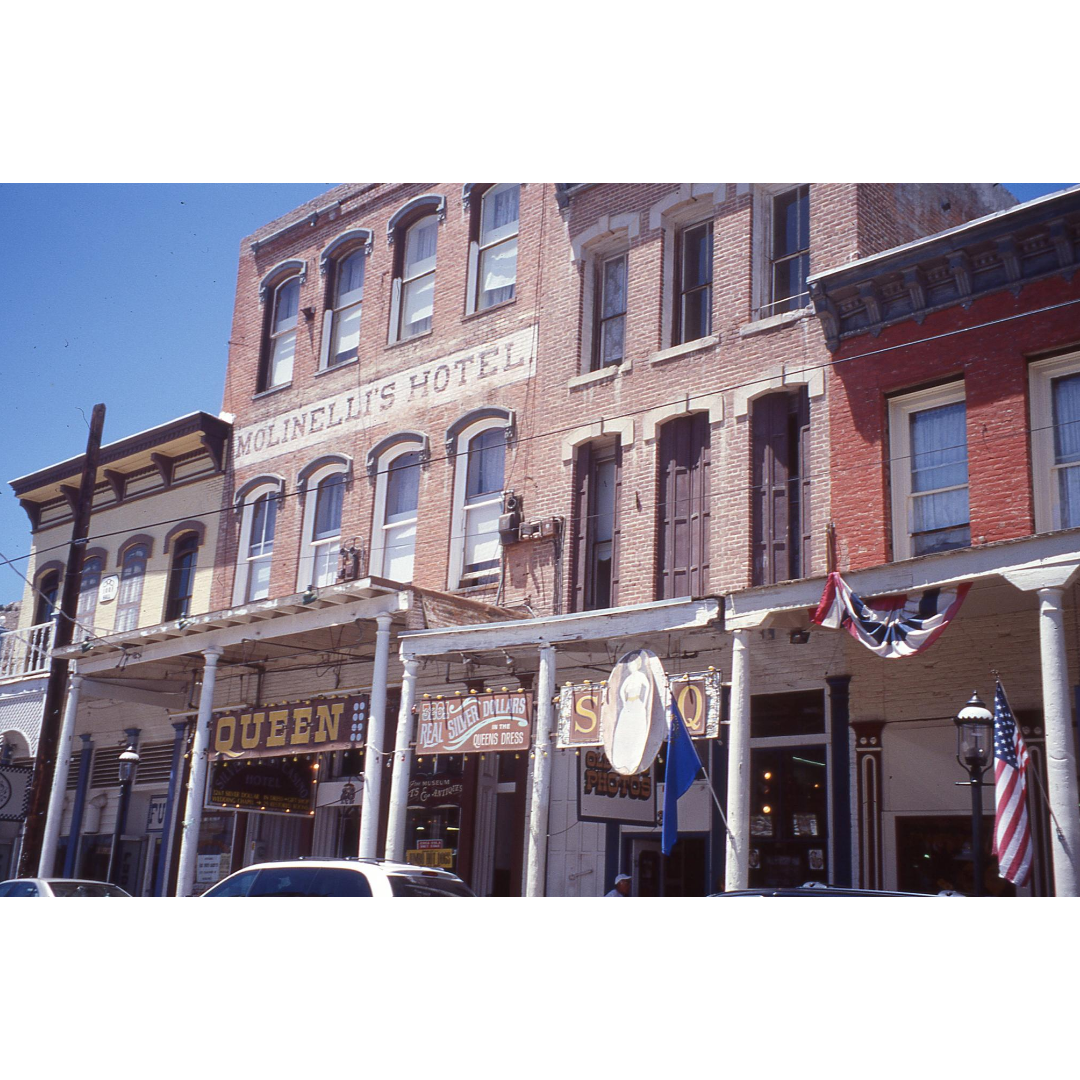Two Historic Virginia Cities – Montana vs. Nevada
Part 2 – Mines, Saloons, and Museums in Virginia City, Nevada
By Helen Serras-Herman
There are two historic, old west mining towns named Virginia
City – one in Montana established in 1863 shortly after the major placer gold
discovery in Alder Gulch, which we discussed in Part 1. The other one is in
Nevada near Carson City, 26.7 miles away from Reno. Virginia City is situated
at 6,250 feet elevation against the backdrop of Mount Davidson.
Originally a silver boomtown, today Nevada’s Virginia City is
a well-preserved authentic historic town, with boardwalks, restored buildings,
museums, old saloons, and two historic underground mines, which offer guided
tours. It is a wonderful family destination where fun and mining history are
intertwined for a memorable visit.
The Comstock Lode
Virginia City, Nevada, became a boom town after the 1859 discovery
of the Comstock Lode, the first major silver deposit discovery in the United
States. Gold was discovered in 1850 in nearby Gold Canyon and Six Mile Canyon,
by Mormon immigrants on their way to the California goldfields. But it took
another nine years to reach the high-grade lode outcrops of silver and gold
quartz ore.
The Comstock Lode – a lode of silver ore - became one of the
greatest precious metals mining districts in the world, producing at its height
over $50,000 per day, a total of 20,000.000 million tons of gold-silver ore and
about $500 million in silver and another $700 million in gold.
The credit for the discovery goes to Irishmen prospectors
Peter O’Riley and Patrick McLaughlin at their small placer operation, brothers
Hosea and Allen Grosh, and James Finney, a native of Virginia nicknamed “Old
Virginia”, in whose honor Virginia City is named. However, these early miners’
names are almost unknown, as the discovery is named after Henry Comstock
(1820-1870), a Canadian who came early in the Virginia City area and took over,
but sold out early (Comstock Mining &
Miners, Eliot Lord, 1883, re-printed in 1959 and 1984 by Nevada
Publications).
The Comstock Lode’s fortunes spurred a mining rush and growth
for Virginia City, Gold Hill, the whole state of Nevada, even contributed to
San Francisco’s wealth. The Consolidated Virginia, Best & Belcher, Crown
Point, and Orphir mines were the big producers among over 90 operating mines.
The Big Bonanza ore body- described to be as high and as long as a football
field - was discovered in early 1873 but lasted only until 1879. The Big Four
Silver Kings, as the four Irishmen were known, were John Mackay, James Fair,
James Flood and William O’Brien.
The Comstock Lode’s difficult mining near the fault zone
required ingenuity and new mining methods. The square-set timbering was
invented on the Comstock in 1860 by Philipp Deidesheimer – a German mining
engineer from California. Heavy timber “cubes” support the underground mining
tunnels and shafts to prevent the ground from caving. These Ponderosa timbers
came from the Lake Tahoe region. The Comstock Lode is called the “tomb of Lake
Tahoe’s forests”. There are 750 miles of underground workings - tunnels,
shafts, stopes, winzes, and inclines.
The other problem was pumping large amount of hot water (up
to 170 degrees Fahrenheit) encountered as the mining went deep into the earth.
The solution was the four-mile Sutro Tunnel constructed by Adolph Sutro,
completed in 1878, which brought automatic air circulation through the shafts
at different elevations.
The 1870 and 1880 census shows a population of around 10,000 for each of those years, but a big ore strike and the Great Fire between those years (Liza McIlwee, VCTC) reduced earlier population numbers reported between 20,000 and 30,000 with about 7,000 miners. There were six schools, seven churches, four newspapers, four banks, eleven cemeteries, 100 saloons, twenty hotels, twenty five lodges, many grocery and clothing stores, and the famous 1860’s Piper’s Opera House open today as a museum and performing arts center. But, as the mine production declined after 1878, so did the population.
Historic Virginia City
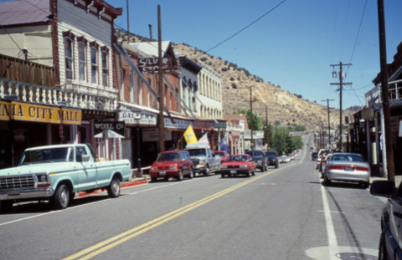
Historic Virginia City
In 1961, Virginia City was declared a National Historic
Landmark. We took a great tour around town on a tractor wagon, and then visited
several old saloons steeped in history and miner’s tales. Among the 1876
original saloons is the Delta Saloon. On
exhibit is the Suicide Table, a true relic as three previous owners committed
suicide there due to heavy losses over this table. The Big Four Silver Kings
played here (www.deltasaloon.com).
Another famous saloon is the Silver Queen inside the Silver Queen Hotel, built in 1860. At the
saloon with the tallest bar built in 1876, an enormous picture of Lucky Lady –
or Silver Queen - hangs on the wall. The 15-feet tall portrait features a
woman’s dress made entirely of 3,261 Morgan silver dollars, minted in Carson
City (read about the Mint in my article The
Carson City State Nevada Museum in Rock & Gem’s June 2021). The number
of silver dollar represents the depth of the Combination Mine shaft. There are
also twenty eight $20 gold pieces (www.silverqueenhotel.net ).
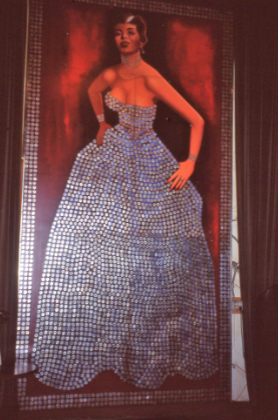
Two Historic Mine Tours
The Ponderosa Mine
Saloon & Underground Mine is located at 106 South C Street. The
40-minute guided tour takes visitors 317 feet deep in the mountain, 52 feet
below the surface, to see the underground tunnels, stopes and shafts. Our guide
(the late John Bailey) shared that only $438 in silver was ever found in the
1800’s. About a century later, the saloon’s owners realized their saloon was
only a short way to the underground Best and Belcher Mine. They dug a tunnel,
connected the mine to the saloon, and started offering tours of the forgotten
mine. The saloon’s 1864 building housed the Bank of California until 1935, and
was turned into a saloon in 1950.
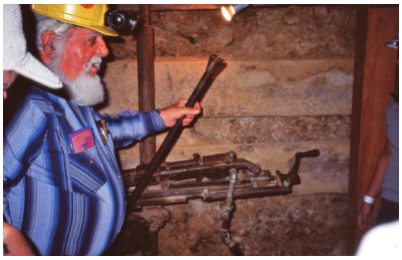
All mine workings are stabilized, with over 300 pieces of
mining equipment on display. The guide explained the square-set timbering
system. The Ponderosa Mine Saloon and their Underground Mine Tours is open
every day, year round. Guided tours run from 12pm to 5pm ( www.visitvirginiacitynv.com/mines-mining-history/) Tel. 775.
847. 7210
The Chollar Mine
was first staked in 1859 by a group of investors headed by Billy Chollar, and
was one of the leading producers on the Comstock Lode with over $17 million in
gold and silver mined.
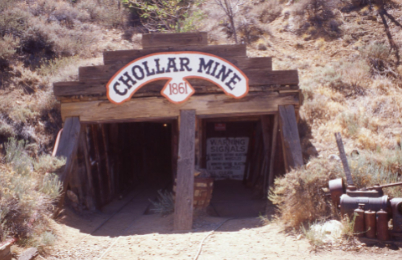
The wonderful guided underground tour at the Chollar Mine
lasts about 50 minutes and takes visitors to the 400-level down an old mine
tunnel. Old mining equipment, pneumatic rock drills, silver ore, and square-set
timbering are some of the mine’s highlights. The guide demonstrates single-jack
drilling, and shares stories of the hardships miners had to endure. Miners
worked eight-hour shifts, most at ten-minute intervals due to the extreme heat,
and earned $4 per day –the highest paid miners in the world. At the end of the
tour, the guide turns the lights out for a few moments and lights up a candle
for visitors to experience the mine’s darkness, and how the miners worked.
The Combination Shaft - known so as the owners of the
Chollar-Potosi, Hale & Corcross, and Savage mines combined their efforts-
is located outside. The vertical shaft goes down 3,262 feet, the deepest shaft
ever sunk on the Comstock, with the most profitable silver ore found at the
2,000 to 3,000 feet levels.
The Chollar Mine is located at the south side of Virginia
City. The mine is open daily 10am to 4pm. Admission is $15 for adults and $10
for children ages 5-12. Visit their website at www.chollarminetour.com or call
775. 847. 0155.
The Virginia & Truckee (V&T) steam train, originally
built in 1870, offers 35-minute leisurely scenic tours from Virginia City to
Gold Hill. The conductor shares Comstock’s stories as the train passes by
seventeen old mines, and stops at the 1859-built Gold Hill Hotel. Endless
tailings piles can be seen along the route (www.virginiatruckee.com).
Museums and Attractions
The Way It Was Museum is a great
place to soak up the local history. The museum displays the most comprehensive
collection of Comstock Mining artifacts, rare photos, and maps of the “Bonanza”
period. An impressive large model shows hundreds of miles of underground mine
network workings. Two assay furnaces are on display, used in the assay process
to melt the gold, silver and other metals in the ore sample. A wonderful double
cabinet hosts a great variety of local minerals.
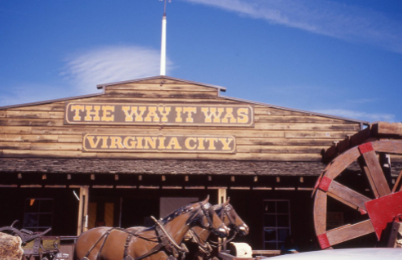
The Way it Was Museum is located at 113 N C Street. It is open year round 10:30am to 4:30pm, and features a continuous-running 16-minute video (www.thewayitwasmuseum.com).
In the center of town, a beautiful memorial - an obelisk with natural stones - has plaques on each side commemorating the Comstock Lode and Philipp Deidesheimer, the square-set timbering inventor.
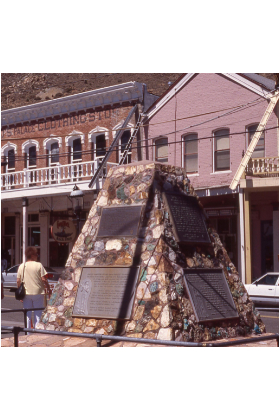
The Virginia City Visitor Center (www.visitvirginiacitynv.com) at 86 S C
Street is a great place to get maps and information about the sites and the
seventeen museums. My sincere thanks go to Tourism Assistant Liza McIlwee for her help.
Helen Serras-Herman, a 2003 National Lapidary Hall of Fame
inductee, is an acclaimed gem sculptor and
gemologist with over 39 years of
experience in unique gem sculpture and jewelry art. See her work at www.gemartcenter.com and her business Facebook page at Gem Art
Center/Helen Serras-Herman
Photo descriptions, All Photos by Helen
Serras-Herman
1. Historic Virginia City, shops, saloons
Virginia City, an 1859 silver boom town, is a well-preserved
historic town
2. Silver Queen
This 15-feet tall amazing portrait of Lucky Lady – or Silver
Queen - features a woman’s dress made entirely of 3,261 Morgan silver dollars
minted in Carson City
3. Drill, Ponderosa Mine
Our guide, the late John Bailey, at the Ponderosa
Mine, shows the German-made pneumatic drill and square drill bit.
4. Chollar Mine entrance
We took the wonderful guided underground tour at the Chollar
Mine, first staked in 1859.
5. The Way it Was Museum
The Way It Was Museum is a great place to soak up the local
history.
6. Comstock Lode Memorial obelisk
In the center of town, a beautiful memorial - an obelisk with
natural stones - has plaques on each side commemorating the Comstock Lode.




